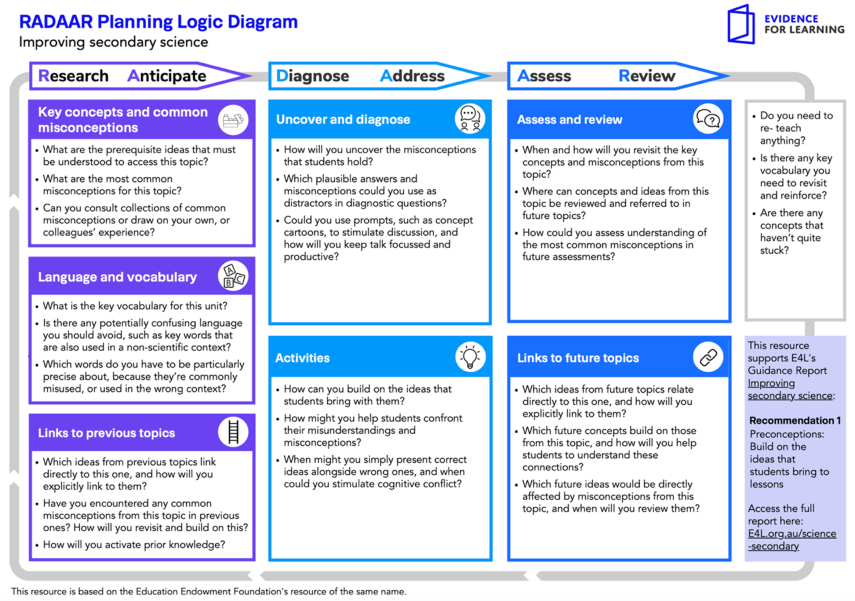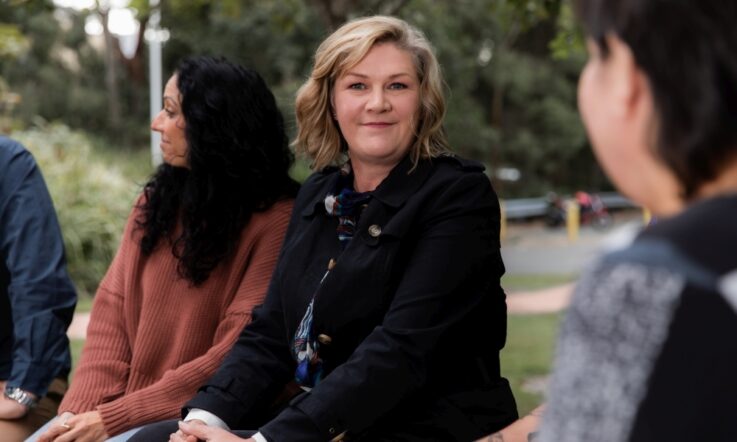Students bring their existing understandings about the world to every lesson. In science and mathematics, these self-constructed ideas do not always align with the concepts, models, language, and processes used within the disciplines. Commonly referred to as misconceptions, these can lead to systematic errors that can build over time and impact further learning.
A focus on planning to address misconceptions is aligned with the Australian Professional Standards for Teachers 1.2 Understand how students learn, 2.1 Content and teaching strategies of the teaching area, 2.2 Content selection and organisation, 3.2 Plan, structure and sequence learning programs, and 5.1 Assess student learning.
Pro-actively planning to address misconceptions is vital to ensuring that every student develops a strong understanding that they can build on over time. This article draws on the best available evidence to support maths and science teachers to effectively plan to address student misconceptions.
In considering misconceptions, it is important to note upfront that these alternative explanations have often been constructed through reasoned observation of a physical phenomenon, or application of partial knowledge of content or a process to a different context. For this reason, you will sometimes see them referred to as preconceptions or alternate conceptions. Examples include:
- Concluding that a force must be applied to an object for it to continue moving, as everyday objects seem to slow to a stop when not pushed.
- Developing an understanding that ‘multiplication makes bigger’ and ‘division makes smaller’ from experience with positive whole numbers greater than one.
Putting the evidence on misconceptions into practice
Evidence for Learning’s (E4L) Guidance Reports on metacognition, science and mathematics draw on extensive reviews of the available evidence to make practical, evidence-informed recommendations (Evidence for Learning, 2019, 2020, 2022a, 2023). They include several key considerations relating to addressing misconceptions:
- Many misconceptions are well known and can be anticipated.
- Teacher knowledge of misconceptions allows the teacher to plan to address them effectively.
- Misconceptions can be uncovered through diagnostic assessment, including specialised diagnostic tools, targeted or hinge questions, and class or small group discussion.
- A supportive classroom environment helps students to feel comfortable sharing their ideas.
- Students can be supported to adjust their ideas through examples and non-examples, discussion, cognitive conflict, and counter examples.
- Changing student thinking is a process and it is important to allow enough time for this.
- Revisiting misconceptions after addressing them can help students identify how their thinking has changed.
- Assessment can be used to check that changes in thinking have ‘stuck’ in the medium-long term.
Planning to uncover and address misconceptions
Planning to uncover and address misconceptions is a key step for putting the evidence into action (Evidence for Learning, 2020, 2022a). E4L’s RADAAR planning tool (Evidence for Learning, 2022b) breaks this down into a 3-step process, with prompts to support teacher planning:
- Research and anticipate possible misconceptions before teaching a topic, including identifying key vocabulary and links to previous learning.
- Diagnose students’ misconceptions and address them directly.
- Assess the impact to see if the ideas have ‘stuck’ and support students to review their understanding make links between ideas.
This is a cyclical process. At times is may be necessary to re-teach or re-visit concepts and vocabulary if it is clear students still hold misconceptions. Working collaboratively to address misconceptions across year levels can help to ensure that student understanding builds over time.
Figure 1. E4L’s RADAAR planning tool (Evidence for Learning, 2022b)

Planning in action
So, what might putting the RADAAR tool to work in planning look like? Let’s step though an example from a very common topic for misconceptions – forces and motion in physics at year 10 level.
Research and anticipate
In the Australian Curriculum at year 10 level, students learn about Newton’s laws and the relationship between force, mass and acceleration (ACARA, 2022a). They have previously encountered this at year 7, which focused on forces acting on objects and their effect (ACARA, 2022b). Due to the conceptual challenges in this topic, and the amount of time passed since students last studied it, activating student prior knowledge will likely require particular attention.
Misconceptions are common in this area. Resources such as the Institute of Physics’ Spark identify many, including: correctly identifying forces; force as a property of objects; heavier objects will fall faster; force is needed to keep an object moving; and action-reaction pairs of forces (IOP, n.d.). Deakin University also has an extensive list of possible misconceptions (Deakin University, n.d.).
Key terms that are commonly confused include: velocity and speed; mass and weight; and velocity and acceleration. At the core of many of these misconceptions is the understanding of what is meant by a force and how it is used to represent interactions between objects.
Teachers working out of field or with less experience in teaching physics may also have misconceptions, even subtle ones, in this topic. Accessing support from colleagues and working collaboratively to plan can be important to overcome this.
Diagnose and address
There are many tools available for diagnosing misconceptions relating to forces and motion, including the extensively developed Force Concept Inventory (Hestenes et al., n.d.). Selecting one or 2 questions from this that relate to a particular misconception could be a quick way to initially gauge student thinking.
Several activities may be needed to address all the potential misconceptions within this topic. Tackling them individually in a logical sequence within the learning program may be more effective than trying to address all at once. The Conceptual Understanding Procedure (CUP) relating to objects falling under gravity (Monash University, n.d.) could be used to both identify and address conceptions of this concept through cognitive conflict and discussion.
Simple graphic organisers such as a Frayer Model could also be used to help students unpack their understanding of key concepts and terminology, such as force or velocity, including the articulation of examples and non-examples.
Taking the time to diagnose and address misconceptions in this topic may require careful prioritisation of what is taught in the time available. Focusing on developing strong conceptual understanding of key concepts, such as the nature of a force and its effect, could be prioritised over the volume of calculations undertaken using F = ma.
Assess and review
Opportunities for both formative and summative assessment will be helpful for identifying progress and any misconceptions that may remain. Diagnostic questions from the Force Concept Inventory (Hestenes et al, n.d.) could be revisited later to quickly identify learning progress. End of topic or end of semester assessments could also be used to revisit key misconceptions and see if key ideas have ‘stuck’.
Students that continue their study of physics beyond year 10 will typically encounter these concepts again in year 11 and 12. Working collaboratively to ensure that there is cohesion of practice and links made between year levels can support students to have greater chance of success in their future studies of physics.
Questions for teachers to consider
- Are there particular areas of content that would be your highest priorities for working with student misconceptions?
- How can you ensure planning to uncover and address misconceptions is a routine practice?
- Where might you find opportunities to collaborate with colleagues to support effective planning for misconceptions?
- What can be put in place to help revisit and reinforce key concepts over time, particularly with content that is only in the curriculum every few years?
Key takeaways
- Misconceptions can lead to errors that can build over time and impact further learning.
- Teacher knowledge of misconceptions and explicitly planning to uncover and address them is vital for supporting student learning growth.
- Many misconceptions are well known, and well-developed tools and resources are often available to support teachers to address them effectively.
References
ACARA. (2022a). AC9S10U05, Science Understanding: Physical Sciences: Year 10. Australian Curriculum v9.0. Author. https://v9.australiancurriculum.edu.au/f-10-curriculum/learning-areas/science/year-7_year-8_year-9_year-10/content-description?subject-identifier=SCISCIY10&content-description-code=AC9S10U05
ACARA. (2022b). AC9S7U04, Science Understanding: Physical Sciences: Year 7. Australian Curriculum v9.0. Author https://v9.australiancurriculum.edu.au/f-10-curriculum/learning-areas/science/year-7_year-8_year-9_year-10/content-description?subject-identifier=SCISCIY7&content-description-code=AC9S7U04
Deakin University. (n.d.). Force, motion and machines. Resources for Teaching Science. Author. Retrieved August 4, from https://blogs.deakin.edu.au/sci-enviro-ed/years-5-10/force-motion-and-machines/
Evidence for Learning. (2019) Metacognition and self‐regulated learning. Evidence for Learning. Available from http://e4l.org.au/metacognition
Evidence for Learning. (2020) Improving mathematics in upper primary and lower secondary. Evidence for Learning. Available from http://e4l.org.au/maths-primary-secondary
Evidence for Learning. (2022a) Improving secondary science. Evidence for Learning. Available from http://e4l.org.au/science-secondary
Evidence for Learning. (2022b) RADAAR planning tool. Evidence for Learning. Available from http://e4l.org.au/science-secondary
Evidence for Learning. (2023). Improving mathematics in the early years with children aged
3‐7 years. Evidence for Learning. Available from https://e4l.org.au/early-maths
Hestenes D., Wells M., Swackhamer G., Halloun I., Hake R., & Mosca E. (2023). Force Concept Inventory. American Association of Physics Teachers. https://www.physport.org/assessments/assessment.cfm?A=FCI
IOP. (2023). Spark: Misconceptions. Institute of Physics. https://spark.iop.org/misconceptions
Monash University. (2001). Conceptual Understanding Procedures (CUPs). Student worksheets – examples. Ex4 Dropping a golf ball and a foam ball. Science Education Research Group. Retrieved August 4, from https://www.monash.edu/science-education/our-research/conceptual-understanding-procedure-cup
Evidence for Learning is developing a resource focused on putting evidence to work in STEM, which you can find here: https://e4l.org.au/stem-in-schools



